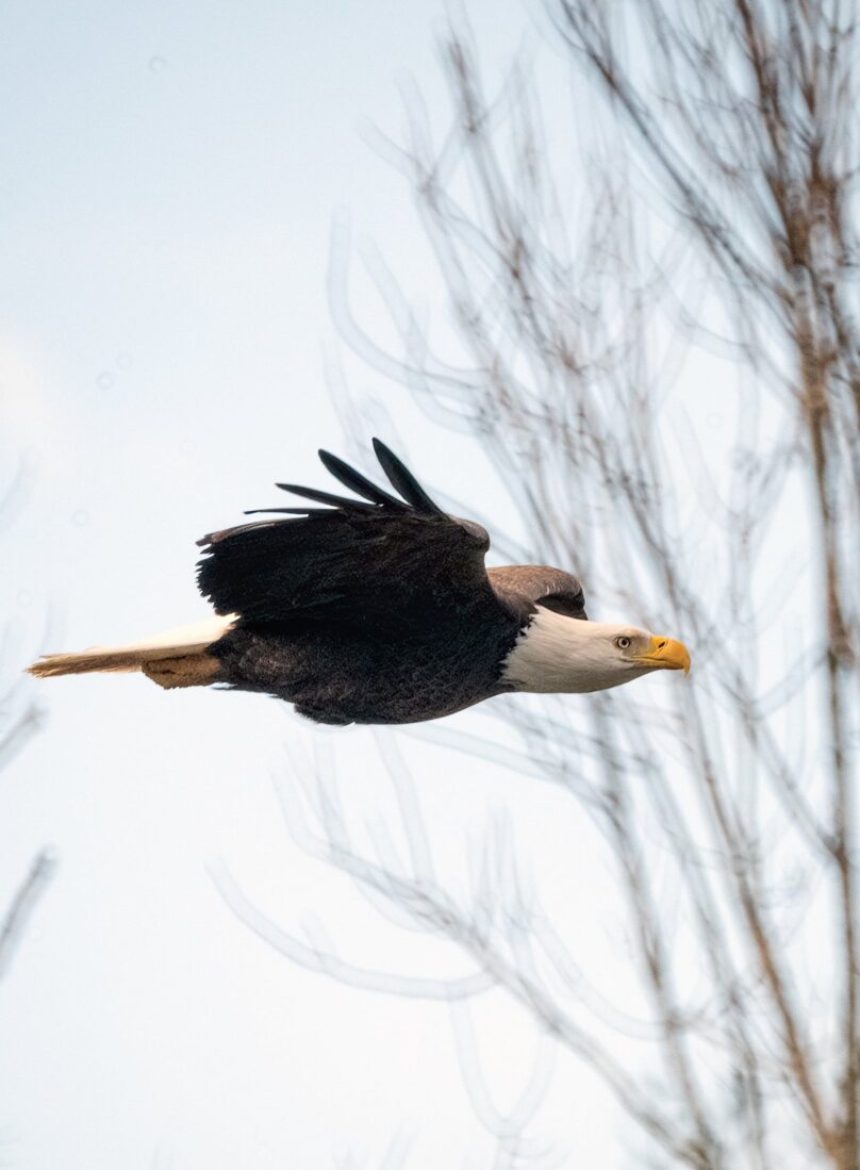There was a time when bald eagles almost disappeared from American skies. In the 1960s and ’70s their numbers plummeted due to widespread use of the pesticide DDT. After the spray was banned in 1972 and the Endangered Species Act passed a year later, the majestic raptors—a symbol of the United States and a sacred animal to many Native peoples—made a dramatic comeback. Today, the range of bald eagles touches every Southern state.
Though some bald eagles do occupy the South year-round, their presence in the region increases during the colder months as they seek milder temperatures and easier access to their primary food source, fish. Nesting season stretches from late fall to spring, too, making the height of winter a great time to spot fledgling eagles.
A bald eagle in flight.
As a rule, the best place to glimpse a bald eagle is near a lake or slow-moving river. Scan treetops and snags—they’ll often perch in order to search for prey—and keep an eye out for large stick nests high in the branches. (If you do identify a nest, you’ve likely found the home a breeding pair will return to for decades.) It’s also easy to recognize a bald eagle in flight, as they tend to soar higher than most birds, holding their broad, dark wings fairly flat as the sun glints off their trademark white head and tail.
Below, find some proven hangouts of bald eagles in the South.
This shallow natural lake in northwestern Tennessee hosts one of the largest wintering populations of bald eagles in the country (as many as two hundred during peak season). Since 1974, Reelfoot Lake State Park has offered bald eagle spotting tours by bus, van, and pontoon boat, or you can opt to canoe among the cypress trees. Look out for rare golden eagles, too—they visit the lake between November and March.
Three Lakes Wildlife Management Area, Florida
Florida has one of the densest concentrations of nesting bald eagles in the lower forty-eight states; biologists estimate that some 1,500 pairs raise their chicks around the state’s many waterways. The heaviest concentration appears to be located in the Prairie Lakes Unit of Three Lakes Wildlife Management Area in Central Florida. Tucked between two lakes, this plot of former ranchland is ringed with 150 nests. Even outside of winter, Prairie Lakes remains a top spot for seeing bald eagles in Florida.
Arkansas River Valley, Arkansas
Arkansas offers excellent eagle spotting statewide, but perhaps the best-known locale is Lake Dardanelle, a reservoir on the Arkansas River near Russellville. The state park offers free viewing tours by boat, and you’ll likely glimpse pelicans and all manner of other waterfowl. Nearby lies the 7,055 acres of Holla Bend Wildlife Refuge, another popular birding spot.
Lake Guntersville, Alabama
Located on the Tennessee River in northeastern Alabama, Lake Guntersville is a known winter retreat for bald eagles. Bordered by rugged bluffs and lush woodlands, the expansive reservoir can be explored by boat tour, or you can scan for the birds from the scenic hollows of Lake Guntersville State Park.
Black Bayou Lake National Wildlife Refuge, Louisiana
During winter bald eagles soar above the winding bayous and ancient cypress groves at this wildlife refuge in northeastern Louisiana. In addition to boardwalks that wind through the wetlands, visitors can post up at the observation deck, which is outfitted with a spotting scope, to view the raptors alongside herons, egrets, and waterfowl.
Caddo Lake, Texas and Louisiana
Caddo Lake stretches 25,400 acres along the border between Texas and Louisiana, encompassing open water, swamp, and one of the largest flooded cypress forests in the country. Bald eagles hunt and nest here by the dozen; take a boat tour, kayak or canoe, or just walk the trails of the refuge or state park to spot them. You might also see wood ducks, and, come springtime, one of the largest breeding populations of prothonotary warblers.






